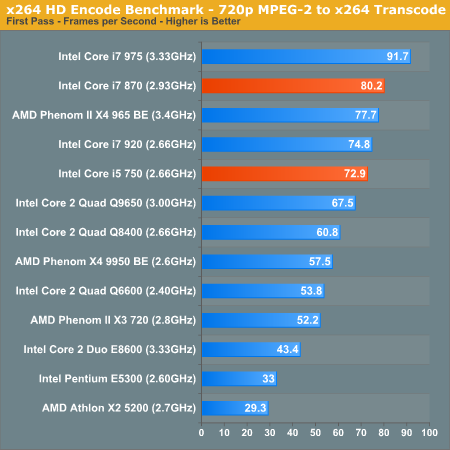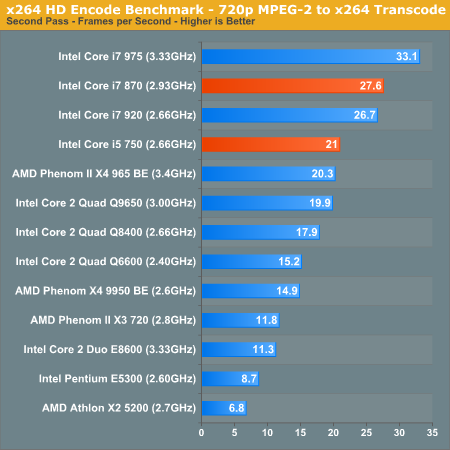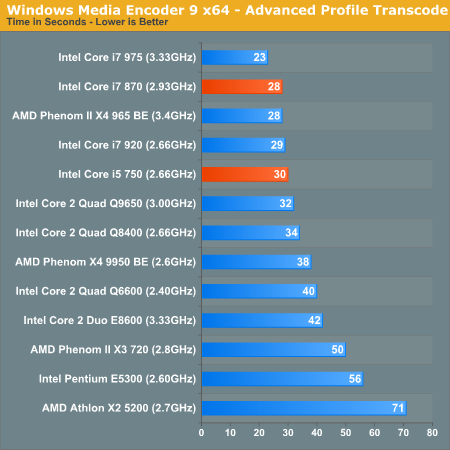Intel's Core i7 870 & i5 750, Lynnfield: Harder, Better, Faster Stronger
by Anand Lal Shimpi on September 8, 2009 12:00 AM EST- Posted in
- CPUs
DivX 8.5.3 with Xmpeg 5.0.3
Our DivX test is the same DivX / XMpeg 5.03 test we've run for the past few years now, the 1080p source file is encoded using the unconstrained DivX profile, quality/performance is set balanced at 5 and enhanced multithreading is enabled:

And we're done. DivX, historically a stronghold for AMD's Phenom II processors (at least compared to their price-competitive Penryn counterparts) is faster on the Core i5 750 than on the Phenom II X4 965 BE. What's wrong with that?
The i5 750 costs $199, the 965 BE costs $245. Intel is selling you more transistors for less than AMD is for once.
x264 HD Video Encoding Performance
Graysky's x264 HD test uses the publicly available x264 codec (open source alternative to H.264) to encode a 4Mbps 720p MPEG-2 source. The focus here is on quality rather than speed, thus the benchmark uses a 2-pass encode and reports the average frame rate in each pass.

In the first pass AMD is quite competitive, outpacing the i5 750, but when we get to the actual encode:

It's close, but the cheaper i5 750 is faster than the Phenom II X4 965 BE once again; Hyper Threading keeps the i7 920 ahead.
Windows Media Encoder 9 x64 Advanced Profile
In order to be codec agnostic we've got a Windows Media Encoder benchmark looking at the same sort of thing we've been doing in the DivX and x264 tests, but using WME instead.

AMD is about 6% faster than the i5 750 here, it looks like the Phenom II does have some hope left for it. Let's see how the rest unfolds...










343 Comments
View All Comments
erple2 - Tuesday, September 8, 2009 - link
[quoting]Not only did the feature that provided the least benefit (triple vs. dual channel) drive the reason for the socket/pin count difference, they gimp the platform with superior tech by cutting PCIE lanes in half[/quoting]
I thought that the X58 has the PCIe controller on the mobo, and the P55 doesn't? That the Lynnfield CPU's had a built-in PCIe controller, whereas the Bloomfields lacked the built-in PCIe controller? That appears to be another reason why intel had to make 2 separate sockets/platforms.
Now, whether that was made intentionally to force this issue with multiple platforms is a side issue (IMO). I don't necessarily think that it's a problem.
JonnyDough - Tuesday, September 8, 2009 - link
"Personally, from a consumer standpoint, I feel Intel botched the whole X58/P55 design and launch starting with the decision to go with 2 sockets. Not only did the feature that provided the least benefit (triple vs. dual channel) drive the reason for the socket/pin count difference, they gimp the platform with superior tech by cutting PCIE lanes in half."I believe it was intentional and not a botch. Intel was trying to separate a high and low end and to sell more chipsets. It's Intel being boss. It's what they do. Confuse the consumer, sell more crap, and hope that AMD stays a step behind. This is why we need AMD.
Intel is good at marketing and getting consumers to jump on the latest trend. Remember the Pentium 4? Why buy a lower ghz chip when the P4 clocks higher right?
The educated consumer waits and pounces when the price is right, not when the tech is new and seems "thrilling". This review is great but no offense it still almost seems to come with a "buy this" spin - which may be the only way a tech journalist can stay privy to getting new information ahead of the curve.
Comdrpopnfresh - Tuesday, September 8, 2009 - link
You purposefully placing the possibility of overclocking solely in the hands of the lower chip, while completely disregarding the history and facts. This-or-that logical fallacy. Third option: You can overclock the higher-clocked chip too.Granted, I see your point about the hardware being of the same generation of the architecture; that lynnnfield is not the tock to bloomfield's tick (or the other way around if how you hear clocks starts mid-cycle) and therefore the silicon has the same ceiling for OC.
But bloomfield is a like a D.I.N.K. household; dual-income-no-kids. When you overclock bloomfield, not only do you have the physical advantage of lower heat-density due to a large die, but you also don't have the whiny pci-e controller complaining how timmy at school doesn't have to be forced into overclocking. The on-die pci-e controller will hinder overclocking- period.
Just like trying to overclock cpu's in nearly identical s775 motherboards/systems. The system with the igp keeps the fsb from overclocking too much. So then what- you buy a dedicated gpu, negate your igp you spent good money on, just to have your cpu scream?
Except in this case, if one were able to disable the on-die pci-e controller and plop a gpu in a chipset-appointed slot (sticking with the igp mobo situation in s775) you'd be throwing away the money on the on-die goodies, and also throwing away the reduced latency it provides.
Has it occured to anyone that this is going to open an avenue for artificial price inflation of ddr-3. Now the same products will be sold in packages of 3's and 2's? Sorry- just figured I'd change the subject from your broken heard still stick on overclocking.
chizow - Tuesday, September 8, 2009 - link
Actually in the real world, overclockers are finding the 920 D0s clock as well and often better than the 965s for sure (being C0), and even the 975s D0. You're certainly not going to see a 5x proportionate return in MHz on the difference spent between a $200 920 and a $1000 975. There is no third option because their maximum clock thresholds are similar and limited by uarch and process. The only advantage the XE versions enjoy is multiplier flexibility, a completely artificial restriction imposed by Intel to justify a higher price tag.
philosofool - Tuesday, September 8, 2009 - link
Not seeing it dude. A little overvoltage and LGA 1156 overclocks with 1366.chizow - Tuesday, September 8, 2009 - link
Yes and early reports indicate they will overclock to equivalent clockspeeds, negating any Turbo benefit Lynnfield enjoys in the review. That leaves less subtle differences like multi-GPU performance where the X58 clearly shines and clearly outperfoms P55.puffpio - Tuesday, September 8, 2009 - link
In the article you refer to x264 as an alternative to h264in fact, h264 is just the standard (like jpeg or png) and x264 is an encoder that implements the standard. i wouldn't call it an alternative.
that would be like saying photoshop is an alternative to jpeg, becuase it can save in jpeg format
puffpio - Tuesday, September 8, 2009 - link
"You'd think that Intel was about to enter the graphics market or something with a design like this."dun dun dun! foreshadowing?
----
and since these parts consume less power yet are built on the same process, I assume they run at lower voltage? If so, since they ARE built on the same process, I'd assume they can survive the voltages of the original Bloomfield and beyond? eg for overclocking...
Anand Lal Shimpi - Tuesday, September 8, 2009 - link
Yes, Lynnfield shouldn't have a problem running at the same voltages as Bloomfield. The only unknown is the PCIe circuitry. I suspect that over time we'll figure out the tricks to properly overclocking Lynnfield.As far as Larrabee goes, I wouldn't expect much from the first generation. If Intel is *at all* competitive in gaming performance it'll be a win as far as they're concerned. It's Larrabee II and ultimately Larrabee III that you should be most interested in.
The on-die PCIe controller is a huge step forward though. CPU/GPU integration cometh.
Take care,
Anand
Comdrpopnfresh - Tuesday, September 8, 2009 - link
Have you seen bios implementations allowing for the controller to be disabled? Know if anyone intends to do this?